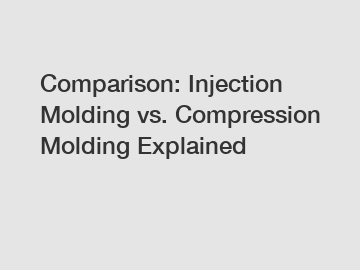Comparison: Injection Molding vs. Compression Molding Explained
Comparison: Injection Molding vs. Compression Molding Explained.
Manufacturers looking to create plastic parts have a variety of molding techniques to choose from, with injection molding and compression molding being two popular options. Understanding the differences between these two processes can help businesses make informed decisions about which method to use for their specific needs. This article aims to explain the key characteristics of injection molding and compression molding, as well as the advantages and disadvantages of each.
Injection Molding.

Injection molding is a widely used manufacturing process that involves injecting molten plastic material into a mold cavity. The plastic material is heated and then forced into the mold under high pressure. Once the material cools and solidifies, the mold opens, and the finished part is ejected. Injection molding is known for its speed and efficiency, making it ideal for high-volume production runs.
Advantages of Injection Molding:
1. High production speed.
2. Consistent part quality.
3. Ability to create complex shapes.
4. Minimal material waste.
Disadvantages of Injection Molding:
1. High initial tooling costs.
2. Limited flexibility for small production runs.
3. Longer lead times.
Compression Molding.
Compression molding is another method used to create plastic parts, involving the placement of preheated plastic material into an open mold cavity. The mold is then closed, and pressure is applied to compress the material into the desired shape. The plastic is heated and cured while under pressure, creating a solid part. Compression molding is often used for low-volume production runs or for parts that require thicker walls and higher strength.
Advantages of Compression Molding:
1. Lower initial tooling costs.
2. Well-suited for large parts and thick-walled products.
3. Ideal for low-volume production runs.
Disadvantages of Compression Molding:
1. Slower production speed.
2. Less design complexity.
3. More material waste compared to injection molding.
Comparison of Injection Molding and Compression Molding.
Speed and Efficiency:
Injection molding is generally faster and more efficient than compression molding due to its automated process and ability to produce multiple identical parts simultaneously.
Tooling Costs:
Injection molding incurs higher tooling costs upfront, as molds are typically more complex and intricate. Compression molding, on the other hand, offers lower tooling costs, making it a more cost-effective option for small production runs.
Production Volume:
Injection molding is best suited for high-volume production runs, while compression molding is ideal for low to medium volume production where cost-effective tooling is desired.
Design Complexity:
Injection molding allows for intricate and complex part designs, making it a preferred choice for parts with detailed features. Compression molding is more limited in terms of design complexity.
Material Waste:
Injection molding generates less material waste compared to compression molding, as the plastic is injected precisely into the mold cavity, reducing excess material and scrap.
Conclusion.
In conclusion, both injection molding and compression molding offer unique advantages and disadvantages depending on the specific requirements of a project. Businesses should carefully consider factors such as production volume, tooling costs, design complexity, and material waste when choosing between the two processes. Ultimately, selecting the right molding technique can help optimize production efficiency and overall cost-effectiveness.
Contact us to learn more about injection molding and compression molding for your plastic part manufacturing needs.
For more dispensing closure, dispensing closure, dispensing closureinformation, please contact us. We will provide professional answers.
195
0
0

Comments
All Comments (0)